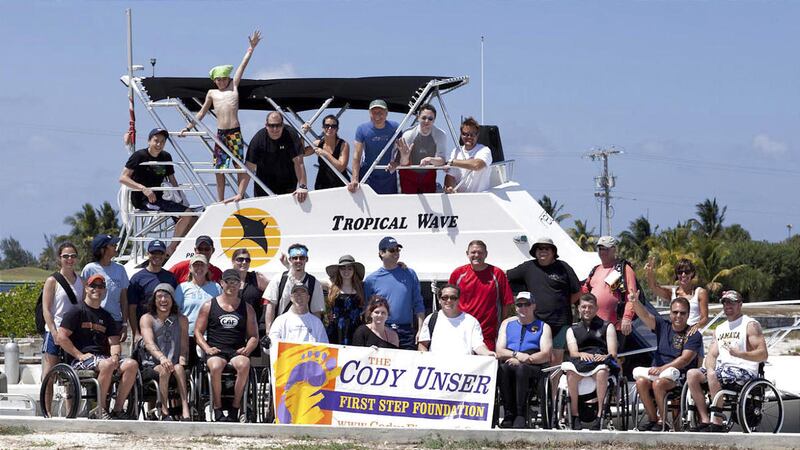ALBUQUERQUE — When Cody Unser dives, she is weightless.
And, for a few minutes at least, she is unencumbered by the wheelchair she has used since she was 12.
Unser, 24, daughter of Albuquerque racing legend Al Unser Jr., was paralyzed from the chest down in 1999 during a sixth-grade basketball game, when she was struck with transverse myelitis, an autoimmune condition that attacks the spinal cord.
Two years later, she earned her scuba certification. She has been diving ever since.
"I always say that it saved my life," says Unser, a graduate student in public health at Georgetown University who lives in Houston. "It's the best thing in the world."
Through the Cody Unser First Step Foundation, which she and her mother, Shelley Unser, started in 2000, Unser has spent years lobbying doctors and gathering funding to research the therapeutic benefits of diving on people with spinal cord injuries.
In May, Unser's vision became reality when researchers spent a week in the Cayman Islands studying the impact of diving on 10 paraplegics and quadriplegics and 10 able-bodied divers. In addition to spearheading the study, Unser was the only woman and non-veteran in the disabled group.
The privately funded study was small, but results were dramatic. Divers with disabilities showed improved strength and dexterity, and those with post-traumatic stress disorder averaged an 80 percent improvement in symptoms, says principal investigator Dr. Adam Kaplin, assistant professor at Johns Hopkins University and psychiatric consultant to the school's Transverse Myelitis Center.
In some paralyzed divers, sensation, tone or motor function improved by 20 percent to 30 percent, according to a Johns Hopkins release.
It was the kind of response Cody Unser expected. For years, Unser had told Kaplin, whom she met at the Transverse Myelitis Center, about tingling sensations in her legs when she dives that last for weeks. When she introduced Kaplin to other disabled divers who had also regained feeling, he was intrigued.
Although Unser started the foundation to raise awareness about transverse myelitis, she has also focused on organizing scuba trips for people with disabilities. In 2005, Unser added diving for veterans with disabilities with a new project called Operation Deep Down.
Working with veterans was a natural move. As Unser traveled around the country, she met veterans injured in Iraq and Afghanistan who sought advice about living with disabilities. She realized diving could help them, too.
In Albuquerque, Operation Deep Down volunteers now train people from all over the country with disabilities and their diving buddies. They also instruct certified divers to teach people with disabilities.
Michele Monsam, who works at Intel and is a member of the Air National Guard, has volunteered with Operation Deep Down since 2008 when she returned from duty in Iraq. Teaching diving to people with disabilities is now a "lifetime commitment."
Paralyzed divers wear webbed gloves, not fins, but the "sense of adventure and serenity is the same whether you're using your hands or your feet," she says.
Monsam trained divers on the Cayman Islands trip and was in the control group.
For participants, the trip was transformative.
"I think the scuba-diving trip fixed the problems I didn't even know I had," says Chris Sullivan, 28, an Army sergeant who was paralyzed when he was shot in the neck in Iraq in 2005. "When it was over, I just felt like a burden was lifted off me."
Sullivan, who lives in Duson, La., loved the surreal feeling of being underwater. He liked it so much that he plans to take his family diving next year.
Underwater, he is not restricted to his chair, he says. He can stand upright and maneuver in the water.
"It's like a whole world that you have total access to," he said.
Al Kovach Jr., a former Navy SEAL and senior vice president of the Paralyzed Veterans of America, helped organize the trip and joined the study. It was his first open-water dive since 1991, when he was paralyzed from the chest down in a parachuting accident.
For Kovach, diving had never been recreation. As a Navy SEAL, diving was simply part of the mission.
Now, he compares diving to meditating or outer space, he said in a telephone interview from his home in San Diego.
"People with paralysis are susceptible to pressure sores," he says. "Once you're in the water, it's so relieving to have that neutral buoyancy. In Cayman, you can see forever. Just going along the coral reefs and seeing all those big fish — it was almost like being explorers."
"It was awesome," he adds. "I can't wait to do it again."
Diving often appeals to veterans with disabilities, Monsam says, because many of them are thrill-seekers. Also, she says, "It's gear-intensive. Guys love gadgets."
Helping veterans
Unser, who presented her study at the Paralyzed Veterans of America Summit 2011 in Orlando, Fla., says she is thrilled with the results.
Simply finishing the study was a "10-year milestone," Shelley Unser says.
Cody Unser hopes the study will spark more research.
"My hope is to get more people in the water and show them what you can do and not what you can't," she says.



